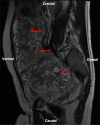Immature ovarian teratoma with gliomatosis peritonei, paraneoplastic hyponatremia and growing teratoma syndrome: a case report and literature review
- PMID: 39118721
- PMCID: PMC11305768
- DOI: 10.1097/MS9.0000000000002309
Immature ovarian teratoma with gliomatosis peritonei, paraneoplastic hyponatremia and growing teratoma syndrome: a case report and literature review
Abstract
Introduction and relevance: Paraneoplastic hyponatremia is often secondary to syndrome of inappropriate antidiuretic hormone secretion (SIADH) by tumour cells. Immature ovarian teratomas (IOT) are uncommon and may present with SIADH.
Case report: A 26-year-old female presented with a 3-month history of abdominal pain and constipation. Imaging identified a mixed solid-cystic right ovarian mass containing fat and peritoneal deposits. Biochemistry showed severe, refractory hyponatremia (117 mmol/l). She underwent diagnostic fertility-preserving right salpingo-oophorectomy and resection of peritoneal nodules with the aim to achieve symptom control and hyponatraemia resolution. Pathology revealed a FIGO Stage 2 Grade 2 IOT with extensive benign peritoneal gliomatosis. Initial management was conservative. After 6 months of active follow-up, a rise in AFP, and recurrent hyponatremia supported the decision to administer three cycles of Bleomycin-Etoposide-Cisplatin chemotherapy. One month later, given radiological disease progression despite satisfactory biomarker response, cytoreductive surgery with complete macroscopic resection was performed. Pathology consisted solely of peritoneal mature glial elements: a growing teratoma syndrome (GTS). The patient remains disease-free after 2 years of surveillance.
Clinical discussion: Specimen histological assessment from the patient's initial surgery showed immature neuroectodermal tubules, which are thought to be the source of vasopressin secretion. The authors hypothesise that recurrent hyponatremia and rising AFP levels represented postoperative disease relapse. Biochemical response despite radiological disease progression was pathognomonic of a GTS.
Conclusion: Paraneoplastic SIADH secondary to an IOT must be considered in female patients presenting with abdominal symptoms and hyponatremia. Management requires a multidisciplinary approach. Serum electrolytes are useful surveillance biomarkers supplementary to tumour markers.
Keywords: case report; gliomatosis peritonei; growing teratoma syndrome; hyponatremia; immature ovarian teratoma; syndrome of inappropriate secretion of antidiuretic hormone (SIADH).
Copyright © 2024 The Author(s). Published by Wolters Kluwer Health, Inc.
Conflict of interest statement
The authors declare no conflicts of interest.
Figures



References
-
- Ayhan A, Fagotti A, Gultekin M, et al. . ESGO Textbook of Gynaecological Oncology, platinum edition. Gunes Publishing; 2023.
-
- Creasman WT, Mutch DG, Mannel RS, et al. . Disaia and Creasman Clinical Gynecologic Oncology, tenth edition. Elsevier; 2023.
-
- Frumovitz M, Leitao Jr. MM, Ramalingam P, et al. . Diagnosis and treatment of rare gynecologic cancers, first edition. Elsevier; 2023.
-
- Berek JS, Anderson DM, Aubuchon M, et al. . Berek & Novak’s gynecology, sixteenth editon. Wolters Kluwer; 2020.
-
- European Society of Gynaecological Oncology . Non-epithelial ovarian cancers in adolescents and young adults pocket guidelines. ESGO; 2019.
Publication types
LinkOut - more resources
Full Text Sources
